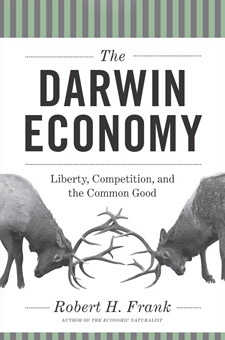The lesson from evolutionary economics is bottom-up self-organization, not top-down government design
A review of The Darwin Economy: Liberty, Competition, and the Common Good by Robert H. Frank. Princeton University Press, 2011, 240 pages. This review appeared online in the Journal of Bioeconomics in March 2012.
When I entered the world of competitive bicycle racing in 1980 no serious cyclist wore a helmet in training, and the leather “hair net” required by some race organizations—thin bands of leather-wrapped cotton stuffing—did nothing more than prevent your hair from getting mussed upon impacting pavement. Bell Helmets already had the technology from their motorcycle division to make a viable crash-tested safety helmet for bicycling, but elite cyclists are an elitist cohort that follows the trends of what looks good as much as what works well. The perception at the time was that a helmet was delimiting on performance and made you look like a “Fred”—two-wheel-speak for geek. Even if an individual cyclist wanted to don protection, unless everyone else did as well the competitive choice was to race sans helmet. When I was sponsored by Bell to compete in the Race Across America—the 3,000-mile nonstop transcontinental bicycle race—they engaged me to help design a helmet that elite cyclists would wear that would, in marketing theory, inspire the masses of two-wheelers to follow in emulation. We came up with the V1-Pro, a model that aped the leather hair net in design but was made of the same compressed polystyrene foam utilized in motorcycle helmets for absorbing the energy of an impact. Nonetheless, it was shunned by the pros until the Union Cycliste International (UCI)—the governing body of professional cycling—mandated the use of safety helmets for all cyclists in all races. No helmet, no race. Period. I was relieved, as were many other cyclists I knew, because I wanted to wear a helmet but didn’t want to stand out or lose a slight competitive edge. In time, as helmet use grew in popularity market forces worked effectively to make them lighter, cooler, and colorfully trendy. Now everyone wears them and we are all better for it. (continue reading…)
Comments Off on Another Fatal Conceit
Last month, the Indiana State Senate approved a bill that would allow public school science teachers to include religious explanations for the origin of life in their classes. If Senate Bill 89 is approved by the state’s House its co-sponsor, Speaker of the House Dennis Kruse, hopes that this will open the door for the teaching of “creation-science” as a challenge to the theory of evolution, which he characterized as a “Johnny-come-lately” theory compared to the millennia-old creation story in Genesis: “I believe in creation and I believe it deserves to be taught in our public schools.” In this bill Kruse is challenging the U.S. Supreme Court’s 1987 decision in Edwards v. Aguillard that the mandatory teaching of a bible-based creation story in Louisiana public schools was violative of the first amendment and therefore unconstitutional (by a vote of 7-2, with Rehnquist and Scalia dissenting). “This is a different Supreme Court,” Kruse defiantly said in an interview. “This Supreme Court could rule differently.”
The language of the bill, however, was expanded by the Indiana State Senate Minority Leader Vi Simpson, a democrat, and includes the possibility of teaching the creation stories of religions other than Christianity. “The bill was originally talking about ‘Creationist Science,’ and I thought that was a bit of an oxymoron,” Simpson told the Village Voice. “I wanted to draft an amendment that would do two things. First, it would remove it from the science realm. And second, school boards and the state of Indiana should not be in the business of promoting one religion over another.” The bill now includes the following proviso: “The governing body of a school corporation may offer instruction on various theories of the origin of life. The curriculum for the course must include theories from multiple religions, which may include, but is not limited to, Christianity, Judaism, Islam, Hinduism, Buddhism, and Scientology.” (continue reading…)
Comments Off on Teaching Allah and Xenu in Indiana
A couple weeks ago, I participated in an online debate at Evolution News & Views with Center for Science & Culture fellow Michael Flannery on the question: “If he were alive today, would evolutionary theory’s co-discoverer, Alfred Russel Wallace, be an intelligent design advocate?” Before reading this week’s post, you can review my opening statement in my previous Skepticblog and Flannery’s reply. The following is my response. A link to Flannery’s final reply can be found near the end of this page.
Michael Flannery’s assessment of Alfred Russel Wallace as a prescient scientist who anticipated modern Intelligent Design theory is premised on the belief that modern evolutionary biologists have failed to explain the myriad abilities of the human mind that Wallace outlined in his day as unanswered and—in his hyperselectionist formulation of evolutionary theory—unanswerable. In point of fact there are several testable hypotheses formulated by scientists—evolutionary psychologists in particular—that make the case that all aspects of the human mind are explicable by evolutionary theory. Flannery mentions just one—Steven Pinker’s hypothesis that cognitive niches in the evolutionary environment of our Paleolithic hominid ancestors gave rise to abstract reasoning and metaphorical thinking that enabled future humans to navigate complex social and cognitive environments found in the modern world. In his PNAS paper Pinker outlines two processes at work: “One is that intelligence is an adaptation to a knowledge-using, socially interdependent lifestyle, the ‘cognitive niche’.” And: “The second hypothesis is that humans possess an ability of metaphorical abstraction, which allows them to coopt faculties that originally evolved for physical problem-solving and social coordination, apply them to abstract subject matter, and combine them productively.” Together, Pinker concludes: “These abilities can help explain the emergence of abstract cognition without supernatural or exotic evolutionary forces and are in principle testable by analyses of statistical signs of selection in the human genome.” Pinker then outlines a number of ways in which the cognitive niche hypothesis has been and can continue to be tested.
In point of fact, Darwin himself addressed this larger problem of “pre-adaptation”: Since evolution is not prescient or goal directed—natural selection operates in the here-and-now and cannot anticipate what future organisms are going to need to survive in an ever-changing environment—how did certain modern useful features come to be in an ancestral environment different from our own? In Darwin’s time this was called the “problem of incipient stages.” Fully-formed wings are obviously an excellent adaptation for flight that provide all sorts of advantages for animals who have them; but of what use is half a wing? For Darwinian gradualism to work, each successive stage of wing development would need to be functional, but stumpy little partial wings are not aerodynamically capable of flight. Darwin answered his critics thusly: (continue reading…)
Comments Off on The Natural & the Supernatural: Alfred Russel Wallace and the Nature of Science
A couple weeks ago, I participated in an online debate at Evolution News & Views with Center for Science & Culture fellow Michael Flannery on the question: “If he were alive today, would evolutionary theory’s co-discoverer, Alfred Russel Wallace, be an intelligent design advocate?” The following is my opening statement in the debate. A link to Flannery’s reply can be found near the end of this page.
The double dangerous game of Whiggish What-if? history is on the table in this debate that inexorably invokes hindsight bias, along the lines of “Was Thomas Jefferson a racist because he had slaves?” Adjudicating historical belief and behavior with modern judicial scales is a fool’s errand that carries but one virtue—enlightenment of the past for correcting current misunderstandings. Thus I shall endeavor to enlighten modern thinkers on the perils of misjudging Alfred Russel Wallace as an Intelligent Design creationist, and at the same time reveal the fundamental flaw in both his evolutionary theory and that of this latest incarnation of creationism.
Wallace’s scientific heresy was first delivered in the April, 1869 issue of The Quarterly Review, in which he outlined what he saw as the failure of natural selection to explain the enlarged human brain (compared to apes), as well as the organs of speech, the hand, and the external form of the body:
In the brain of the lowest savages and, as far as we know, of the prehistoric races, we have an organ…little inferior in size and complexity to that of the highest types…. But the mental requirements of the lowest savages, such as the Australians or the Andaman Islanders, are very little above those of many animals. How then was an organ developed far beyond the needs of its possessor? Natural Selection could only have endowed the savage with a brain a little superior to that of an ape, whereas he actually possesses one but very little inferior to that of the average members of our learned societies.
(Please note the language that, were we to judge the man solely by his descriptors for indigenous peoples, would lead us to label Wallace a racist even though he was in his own time what we would today call a progressive liberal.) (continue reading…)
Comments Off on Alfred Russel Wallace was a Hyper-Evolutionist, not an Intelligent Design Creationist
Can burn patients really be healed from a distance by phone?
A couple of weeks ago I was at a meeting with television producers at a Pasadena, California hotel when I ran into a man named Richard Greene whom I had met last year at the debate that Leonard Mlodinow and I did with Deepak Chopra and others at Chapman University. With him was a woman named Dr. Marja Pronk, whom Greene introduced as someone who can heal burn patients from a distance by phone, and that she learned this skill under the tutelage of one Dr. Philippe Sauvage. Greene was interested in having me test Dr. Pronk while she was in town, but we ran out of time and the protocols and ethical considerations of intentionally burning either people or animals were prohibitive (in my view) and so at present we are still working on how this claim might be tested under controlled conditions. If you have any suggestions on how we might do this while also meeting the ethical requirements of an Institutional Review Board or Ethical Review Board that overseas the ethical treatment of human and animal subjects in experiments, please let me know.
First, I will provide you the background I was provided followed by my own thoughts on what it would take to test such a claim, along with my thoughts in between on Philippe Sauvage, which as you shall see is making extraordinary claims that go far beyond healing burn patients.
Richard Greene sent me this background material:

As we discussed, the claims made by Breton “healer” Dr. Philippe Sauvage and his co-workers, including medical Dr. Marja Pronk (http://www.youtube.com/watch?v=sshO4IrvJzI and www.sosburn.info) are astounding and challenge almost every belief we have in Western science. To date there have been approximately 500 who have benefited from this technology in 29 countries (including 46 states in the US). Here, for example, is a video of 22 year old Chris Fleming from Ontario, CA. and some press clippings from Africa: (continue reading…)
Comments Off on Burning Man



